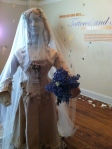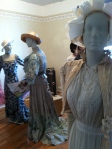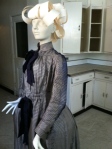 Minh-Ha’s post yesterday reminded me of this 2002 essay called “Orientalist Kitsch” I wrote for poppolitics.com in the aftermath of the “Wong Brothers Laundry Service” t-shirt designed and distributed by Abercrombie & Fitch. It’s about Abercrombie, but also not — this was more an early exploration of the aesthetic of “thrift store chic,” retail race irony, and how we might begin to understand its referential fervor for things past as something other (if not less sinister) than the outright replication of stereotype.
Minh-Ha’s post yesterday reminded me of this 2002 essay called “Orientalist Kitsch” I wrote for poppolitics.com in the aftermath of the “Wong Brothers Laundry Service” t-shirt designed and distributed by Abercrombie & Fitch. It’s about Abercrombie, but also not — this was more an early exploration of the aesthetic of “thrift store chic,” retail race irony, and how we might begin to understand its referential fervor for things past as something other (if not less sinister) than the outright replication of stereotype.
This sentence is key: “The production of these caricatures is not a gesture to reinstate turn-of-the-century Chinese exclusion, legal discrimination or even the emasculation of Chinese men, as much as it is a dismissal of these histories as meaningful in the present.” I’m not sure what this would look like if I wrote it today. Oh, interesting footnote: this essay was reprinted in a textbook on business ethics!
__________________________
Desperate never looks good on a preppie. After a series of blows to the clothiers’ significance on the landscape of cool, the Gap, J. Crew and Abercrombie & Fitch are facing a crisis of cultural and financial capital. Over the last few years, stocks and sales slumped in an embarrassing snub of the brands, and the boom of store openings yielded less profit than the retailers had hoped.
But when Ohio-based Abercrombie & Fitch released a line of t-shirts in April depicting Chinese laundry workers and smiling Buddhas, captioned by groan-worthy puns, the brand found itself launched into the newspapers and television news with the aid of media-savvy Asian American college students protesting the reproduction of century-old caricatures. Activists criticized the t-shirts for denigrating Asian men, trivializing “an entire religion and philosophy,” and offending Asian Americans.
And even as company spokespersons claimed innocence and regret, protests were staged outside the retailers’ stores, boycotts were organized across e-mail lists, and demands for “respect” for Asian Americans as a lucrative market were sounded.
I have to confess, I would rather wear plastic garbage bags and orange legwarmers (which I would do now if I could find some) than sport the sartorial remnants of Reagan-era preppie. And I was hardly shocked by the “Get Your Buddha on the Floor” or “Wok-n-Bowl, Let the Good Times Roll — Chinese Food and Bowling” t-shirts, only the latest splashes in the tidal wave of kitsch merchandising and “orientalia” that’s been stocking store shelves for years now.
But what this particular instance does reveal is that the demand for mimetic realism and “positive” images of racial and ethnic populations in popular culture is often inadequate — and fails to address the other, often more complicated messages embedded in these caricatures.
I am not arguing that Abercrombie & Fitch is funny, daring or even interesting. (Again, have you seen the clothes? Strictly dullsville.) This line of t-shirts is dumb and boring, on top of the printing of these caricatures. On the other hand, Abercrombie & Fitch’s now infamous “Wong Brothers Laundry Service — Two Wongs Can Make It White” t-shirt is not meant to function as an “accurate” representation of Chinese masculinity. (Although the correlation between “white” and “right” in the pun is both banal and striking.)
The clothiers acknowledge these are not realistic images. To accuse the company of “misrepresenting” Chinese or Asian men, culture, whatever, with negative stereotypes, is to forego the messier aspects of contemporary cultural politics. The standard criticism — articulated during the controversy as a matter of “misleading [consumers] as to what Asian people are” — does not suffice.
While these images are surely reproductions of racist caricatures — that is not up for debate — to criticize them as “misrepresentations” assumed that the meaning of visual images is obvious, and the only way to think about representation is through its relation to realism. These analyses argue that Abercrombie views Asian Americans as laundry workers or (as one angry editorial writer put it) a “mass of consumers [so] full of self-hate and self-loathing that they will latch onto any negative stereotype of themselves and parade it around town like a yellow minstrel.”
Unfortunately, the implications of this approach limit images to two categories: stereotypical (negative) and realistic (positive); and Asian Americans to two categories: authentic (protesting) or assimilated (buying). The criticism that these t-shirts “sell Asian self-hate and shame,” or that Asian Americans who might buy these t-shirts are “whitewashed,” ignores the possibilities for other kinds of consumers, images or interpretations of commodities.
We know by now that no mass cultural production is shaped outside of corporate management and market influence. We know capitalist culture is able to assimilate even the most revolutionary, or in this case reviled, sorts of images or themes, and in the process often reproduces and repackages uneven social relations. But it may be that because we already know these things, we can begin to ask other questions about how this happens. This does not mean we abandon the analysis of popular culture for its reproduction of racist stereotypes, gender norms or social restrictions; on the contrary, by thinking about things like form and aesthetics, it might mean that we are able to take the politics of popular culture more seriously.
The corporatization of thrift store chic by retailers like The Gap and Abercrombie & Fitch, and other chain stores like Urban Outfitters, has produced “Rub My Belly Buddha” and “Art’s Auto Body” tees in a simulation of a secondhand sensibility and follows the rise of kitsch (so often typed as “trashy” or “low class”) as the cultural capital of “cool.” In this instance, we need to examine the emergence of what could be termed “orientalist kitsch,” in which the caricature is resurrected and marketed. The first thing we have to account for is that the reproduction of an image of a historical stereotype right now is not the reproduction of the meaning of the stereotype in its original social creation. If we understand these commodity images as kitsch, we can engage this particular image of Chinese laundry workers as a function of marketing strategies such as parody and irony.
The public relations arm of Abercrombie suggested that these t-shirts were meant to be funny. Ironic, right? But in this instance, irony is conservative in its operation. It implies that if a long enough view is taken, all histories, current events and individual dramas are insignificant in the “immensity of life.” The production of these caricatures is not a gesture to reinstate turn-of-the-century Chinese exclusion, legal discrimination or even the emasculation of Chinese men, as much as it is a dismissal of these histories as meaningful in the present.
The same effect is at work in the recycling of revolutionary iconography or heavy metal tour t-shirts. This leveling effect depoliticizes the social powers and conditions that produced these individuals, populations or movements. South American guerillas, heavy metal progenitors and Chinese laundry workers are made to occupy the same horizon as commodity images or arrested moments divorced from their specific historical significance.
Of course, what distinguishes the “Two Wongs’ t-shirt from one featuring Che Guevara or Judas Priest is that it is an image of a racist stereotype. Nevertheless, this transformation process (turning caricature into kitsch) is a different order of naughty than the argument that these images faithfully reproduce stereotypes can explain.
These images reproduce stereotypes only to turn them into kitsch, signifying instead a deliberate “eh” to historical significance or meaning. That it is a racist stereotype makes this an admittedly anxious operation, as it skittles between declaring a “postracist” state and resurrecting old ghosts and bad memories.
Accordingly, the t-shirts cannot be understood outside of their status as kitsch commodities, and whose cultural capital circulates precisely because of their “bad taste” — witness their resale for as much as $250 on eBay as collectors’ items. In the language of kitsch, “bad taste” is a valuable quality, and “bad taste” sells to the hip, urban consumer of tiki bars, wobbly-headed dashboard dogs, mullet paraphernalia and Buddha t-shirts. And because these items are typed as trashy or low class — the (sometimes faux) detritus of thrift stores and garage sales — their purchase as kitsch is accompanied by the necessary wink, which distinguishes the wearers of the t-shirts from those who might really work at Art’s Auto Body. This is a wink with no memory or history, or in the case of Abercrombie, a wink with no concern for memory or history.
But while “bad taste” may function to reiterate class distinctions and depoliticize the commodity, it can also serve as a complicit critique of “good taste” and the hope for a “positive” image, by forcing us to consider what these are. What makes for “good taste”? (Martha Stewart? High culture?) What does a “positive” image look like? (Middle-class? The good girl who doesn’t kiss on the first date?) Clearly both are mediated values, which (usually) reproduce class distinctions and a hygienic version of aesthetics and populations.
Abercrombies’ reinvention of the elite classics — polo shirts, chinos, whatever — has for years balanced the brand image on the sensibility of a privileged whiteness steeped in hedonism. The thick quarterly catalogs feature luscious models, many recruited from college campuses and most of the Anglo-Saxon type, frolicking nude or lounging in stately dorm rooms and lush football fields in suggestive (and often homoerotic) poses. This provocative approach garnered the censure of cultural conservatives; the rightwing fundamentalist Bob Jones University banned the Abercrombie logo from its South Carolina campus two years ago, while Michigan’s attorney general pushed Abercrombie to shrink-wrap and slap “adults only” labels on the catalogs.
 |
I cite this history of censure not to cheer Abercrombie & Fitch for daring to frighten the cultural conservatives (which frankly isn’t hard), but to highlight the complaints about its complicated brand image, dependent upon the coupling of class and race privilege with a “natural” sensuality.
Rather than examine the complex and often contradictory modes of representation and social powers mobilized by this brand image, the recent criticisms of Abercrombie for retailing controversies like the “Wong” t-shirts too easily and quickly articulate a conservative leaning toward “good taste” and realism. An article in a left-leaning Asian American student newspaper accuses the retailer of “skirting the rules,” and that the “Abercrombie and Fitch catalog stunts encourage behavior [like underage sex] that flaunts social conventions.”
Since I’m generally for the “skirting” and questioning of social norms, the pairing of an Asian American critique of racism with a social conservatism of sexual propriety and obeisance to “rules’ seems to be a disturbing and dangerous strategy. Here, the critique of a racist stereotype is hinged upon the reproduction of class distinctions of “good taste” and social norms of “positive” behavior models. Wow, problematic much?
This complaint about “skirting the rules,” like the suggestion that Abercrombie & Fitch “respect” Asian Americans as a target market (which itself skirts dangerously close to a “model minority” hurrah), forces us to re-imagine the stakes and strategies in Asian American cultural politics. I am not arguing to invalidate the critique of the caricature, only that we complicate that critique.
In any case, Abercrombie & Fitch has so far profited from the controversy. And, for the record, I don’t think they ever believed their own publicity, that “we thought Asians would love this t-shirt.” Shares in Abercrombie sold at $33.30, a 52-week high, on April 18, the day the t-shirts were pulled from store shelves and the company offered its apologies. (And what has gone for the most part unremarked during the protests is the sweatshop labor that no doubt produces the casual clothing in factories and free trade zones in Asia and Central America.)
But to demand purity in pop culture makes no sense. Instead of dismissing popular culture (and its audience) for the fact of its messy manufacture, we need to probe further to examine the character and range of any given commodity form’s power and possibility, what moment of crisis or contradiction it might represent, what meanings it might afford. At the very least, these controversies should remind us that all images and representations are staged — stereotypical or realistic, negative or positive — and, as such, we’re only as authentic as “our” kitsch, which is to say, not at all.
 Here are some photos from a really wonderful exhibit I just saw at Governors Island called “Tattered and Torn: On the Road to Deaccession”. The dresses on display here are being “deaccessioned” (removed from museum collections) because they’ve been deemed too damaged to display. What’s ironic but probably not too surprising is that their compromised condition actually enhances their value as sites of critical engagement.
Here are some photos from a really wonderful exhibit I just saw at Governors Island called “Tattered and Torn: On the Road to Deaccession”. The dresses on display here are being “deaccessioned” (removed from museum collections) because they’ve been deemed too damaged to display. What’s ironic but probably not too surprising is that their compromised condition actually enhances their value as sites of critical engagement.



























